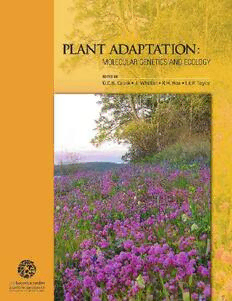
Plant Adaptation: Molecular Genetics and Ecology PDF
173 Pages·2004·5.523 MB·English
Most books are stored in the elastic cloud where traffic is expensive. For this reason, we have a limit on daily download.
Preview Plant Adaptation: Molecular Genetics and Ecology
Description:
Этот сборник посвящён различным аспектам адаптации растений.ContentsChapter 1. The new science of adaptation: an introduction.Chapter 2. Discussion report: an intellectual framework for a plant adaptation scienceChapter 3. Pathways to plant population genomicsChapter 4. Evolvability and the raw materials for adaptationChapter 5. Nucleocytoplasmic incompatibility fosters speciationChapter 6. Discussion report: answered and unanswered questions in plant adaptationChapter 7. Plant population genomics, linkage disequilibrium mapping and the genetics of adaptationChapter 8. Genomic approaches to identifying quantitative trait loci: lessons from Arabidopsis thalianaChapter 9. Experimental analysis of adaptive landscape topographiesChapter 10. Terpene synthases and the mediation of plant-insect ecological interactions byterpenoids:amini-reviewChapter 11. Adaptation in plant speciation: empirical evidence for the role of selection in the evolution of isolating barriers between plant speciesChapter 12. Discussion report: new methods and tools for plant adaptation – what do we need?Chapter 13. Trends in the evolution of edaphic specialists with an example of parallel evolution in the Lasthenia californica complexChapter 14. Floral adaptations and biotic and abiotic selection pressuresChapter 15. Polyploidy and plant adaptation: a framework for future researchChapter 16. Evolutionary genetics of self-incompatibility in a new “model” plant: Arabidopsis lyrataChapter 17. Natural variation among accessions of Arabidopsis thaliana: beyond theflowering date, what morphological traits are relevant to study adaptation?Chapter 18. The study of ancient adaptation: a case study of a phytochrome gene pair from early-diverging angiospermsChapter 19. The variable nature of herbivore defense: evidence for a rapidly diverging Kunitz trypsin inhibitor gene in Populus
See more
The list of books you might like
Most books are stored in the elastic cloud where traffic is expensive. For this reason, we have a limit on daily download.
